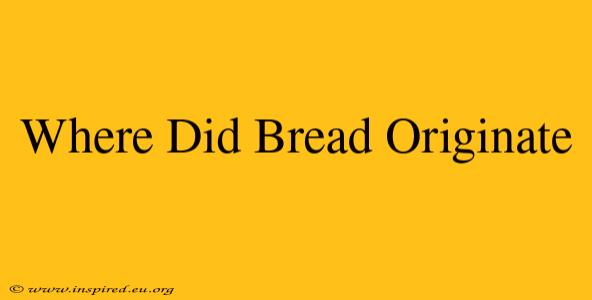Bread, a staple food across the globe, boasts a history as rich and varied as its countless forms. Pinpointing its exact origin is difficult, but evidence suggests breadmaking emerged alongside the development of agriculture, thousands of years ago. This article delves into the fascinating journey of bread, from its humble beginnings to its global dominance.
The Dawn of Bread: Early Evidence
While the precise moment bread was first made remains a mystery, archaeological findings offer compelling clues. The earliest evidence points to the Near East, specifically the region encompassing modern-day Iraq, Syria, and Turkey. Excavations have unearthed remnants of flatbreads dating back to the Neolithic period (around 14,500 years ago). These early forms of bread differed significantly from the loaves we know today. They were likely simple, unleavened flatbreads made from ground grains.
The Fertile Crescent's Role
The Fertile Crescent, a region famed for its agricultural innovations, provided the ideal conditions for the development of bread. The abundance of wild grains like emmer and einkorn wheat allowed early humans to experiment with food preparation techniques. The process of grinding grains into flour, combined with the discovery of fermentation, marked a significant leap forward in breadmaking.
From Flatbreads to Leavened Loaves: A Technological Leap
The invention of leavened bread, using yeast or sourdough starters, represented a technological breakthrough. Leavening significantly altered the bread's texture and flavor, resulting in a lighter, airier product. Evidence suggests that leavened breadmaking emerged sometime between 6,000 and 4,000 years ago. This development was likely an accidental discovery, perhaps due to naturally occurring yeasts contaminating dough.
The Spread of Breadmaking
As agricultural practices and trade routes expanded, breadmaking techniques spread across continents. Ancient Egypt, Greece, and Rome all had sophisticated breadmaking traditions, with specialized bakeries and a diverse range of breads. The Romans, in particular, played a crucial role in disseminating breadmaking technology throughout their vast empire.
Bread Across Cultures: A Global Phenomenon
Today, the sheer variety of bread reflects the cultural diversity of the world. Each region boasts its unique bread traditions, reflecting local ingredients and culinary practices. From the crusty baguettes of France to the fluffy naan of India, the humble loaf continues to play a central role in diets around the world.
Regional Variations: A Culinary Tapestry
- Europe: A wide array of breads exists, reflecting diverse grains, baking techniques and culinary histories.
- Asia: Flatbreads, steamed buns, and fermented breads dominate the Asian culinary landscape.
- Africa: Injera, a spongy flatbread made from teff, is a staple in Ethiopian and Eritrean cuisine.
- Americas: Cornbread, tortillas, and sourdough breads represent the diverse traditions of the Americas.
The Enduring Legacy of Bread
Bread's journey from simple flatbreads to the diverse range of loaves we see today is a testament to human ingenuity and culinary innovation. Its enduring popularity highlights its vital role as a source of sustenance and cultural identity. The ongoing evolution of breadmaking continues to shape culinary landscapes worldwide, ensuring its place as a cornerstone of human civilization.
Further Reading:
- Link to a reputable source on ancient breadmaking
- Link to a reputable source on the history of wheat
(Remember to replace the example links with actual links to relevant and authoritative sources.)
